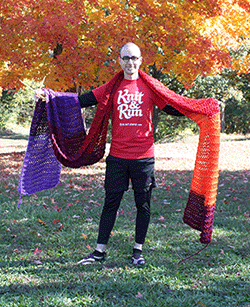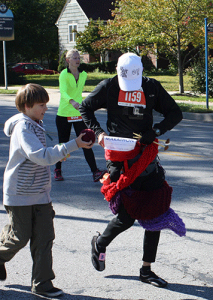Featured in the New York Times and around the world, David Babcock became the Guinness world record holder for knitting the longest scarf (12 feet!) while running a marathon in Kansas City last October. Along with a whole lot of skill and endurance, David credits his choice in using Lion Brand’s Hometown USA as a factor in his accomplishment!
| 1. Which came first knitting or running? It’s not an easy answer — it’s a timeline of failure and discovery for both with middle-aged knees, toys no one wants to play with, and hats no one wants to wear. I started trying to run for exercise in 2009 at age 37, but had a lot of knee pain, so it was an off-and-on thing. I watched the NYC marathon that year and noticed some barefoot runners but it would take almost two years to figure out how to manage the knee pain for myself. The end of that same year a student of mine made a crochet hat for me. Over Christmas break I decided that the hat was too short and learned how to crochet to extend it myself. By February 2010 I had some basic skills and discovered amigurumi-style toy-making. Over the next Christmas break I bought a beginning knitting kit but didn’t get into knitting until that fall in 2011. |
 |
By the following spring I had found that minimal-style running resolved my knee issues and by mid-April 2012 I was running in water socks and had found Susie Hewer’s blog. (Editor’s note: Susie Hewer is a runner/knitter as well. She held the world record for knitting the longest scarf while running a marathon before David!)
2. How has your running program evolved to support the knitting? Did you have a support network for help/advice?
It took a lot of experimenting just to be able to run without knee pain. With minimal running I don’t swing my arms and I don’t bounce up and down. This discovery made the question possible, “can I crochet and run?” I started experimenting by holding my hands together in front of my chest while running. On my first attempt I used size 3 cotton crochet thread and a 2.75mm hook. I tied a ziploc bag to my shorts drawstring with a small ball of yarn and the hook inside. I managed to do about a golf ball-sized amigurumi for 30 minutes before the yarn ball was too tied up in knots to do any more. The experiment worked okay but was too small to be practical and had too many involuntary increases where I couldn’t tell if I had already been through that stitch.
I checked out Ravelry to see if I could find some help or advice and one group I joined is called, “knitters who like to knit while walking and singing sea shanteys“; two more are, “crafty walkers” and “running with sharp objects“. I joined a few men’s groups as well. People online are nice, amazed, and often helpful but mostly it is an opportunity to share my experiments with a small niche.
My next experiment was 16 inch, size 7 circular knitting needles and a skein of worsted weight cotton. Cotton was too sticky when wet and the skein wouldn’t turn free. From there I branched out into nylon on various spools and belts. Eventually I figured out something that works for making nylon bags. It took a couple of runs to work up a large bag. I did a few runs with two sets of circulars for smaller bags.
It takes longer to get ready to run if I am knitting. There is a lot of equipment to consider including a camelback style water bladder because I can’t hold a water bottle. At first I tried to keep my running pace as close as possible to my non-knitting pace. I noticed that I can’t tolerate really hot temperatures when knitting and running, too much sweat, wet, and frustration. Running on a treadmill became a lot more fun when I had something to do.
3. What equipment did you use? Anything specialized or custom-made?
For the record scarf I used a pair of Boye Perfection Points plastic 10 inch, size US15, 10mm knitting needles. The record specified 30 stitches across in garter stitch and the 10mm needle maximum. I knit the scarf at a loose gauge and found in training that my stitches would fall off the ends of the needles. I cut out two leather circles about 2 inches in diameter with a hole in the center that just barely allowed the needle to pass. I then gathered the circle at the end into something like a three pointed fortune cookie and glued the edges together. The large shape keeps the yarn from slipping off. The fortune cookie rotates on the ends easily. The leather doesn’t scrape me up on turns and passes and holds up to the sweaty hands. Wooden clothes pins work really well to clamp to the larger needles and hold stitches on when you have to take a break or change yarn.
I have used two different fanny packs, both with a fairly square pocket that doesn’t flatten when around my waist. I use a plastic bag in the pack to keep the yarn dry as the pack gets wet from sweat at my waist and dripping down from my hands and head. I wind my own balls to keep them as round and even as possible so they will spin freely in the bag. The zipper on the pack is closed just enough to keep the ball from popping out the top – most of the time.
For already-knit portions I have loops of paracord that I made by melting together the ends of an 18 inch length. The loops go around the whole scarf section and then through itself before being attached to a carabiner attached to the pack. Attaching the carabiner directly to the scarf results in pulled stitches. Encountering knots mid-run is very frustrating. If your yarn spins too freely it will knot up or come spilling out your pack in big loops. And yes, I run with scissors.
 4. How have people reacted to your accomplishment? Any odd or memorable comments?
4. How have people reacted to your accomplishment? Any odd or memorable comments?
People that knew me already use it as confirmation of my enduring oddity. I heard from old friends who caught the news and used it as a prompt to reconnect. Some of my students knew about it and others had to Google it. It was fun to have a week with radio interviews from three different cities across Australia.
I really like that it makes people laugh or smile. I have a long list of hoped-for reactions from people: a donation for Alzheimer’s Research, a man deciding it’s okay for men to knit, anyone deciding they should learn to knit, anyone deciding they should go ahead and do that very silly and potentially embarrassing thing that they have been thinking about. One friend wrote about how it was a perfect example of an artist’s view of life and doing creative things because you can. Another friend told me that I inspired her to jump into large creative project.
I really hope that this can be a teaching moment. In school I try to stress the importance of failure and experimentation. Creativity means doing something where you don’t have all of the answers, something where you don’t know how it is going to turn out. You start with a question, “What if?” or “I wonder if I can?” go for it and fail. And then keep experimenting and learning until it turns out okay.
From my point of view knitting while running isn’t really all that unusual. I can connect all of the little steps that led up to this one big odd thing. I want to be supportive of other people’s odd and creative efforts like they are of mine. On the marathon one volunteer yelled out, “You are my new favorite person!”. I yelled back, “And you are mine!”.
5. What does your family think? Do they knit and/or run?
It is not all that unusual for them to see me do things like this. It is just what David/Dad does. I believe that they are more proud than embarrassed for me. If you grew up with siblings you know how you carefully make choices about what you will be good at in competition with a sibling. I want to be careful to include my family and encourage them where they are interested. I was able to do the record run with my brother-in-law at my side for his first race ever. My wife is patient as always. My children are constantly learning new things and jump from one thing to another. I have taught all of them the basics of knit and crochet, but the challenge is that they need to decide on their own to make it their own skill and do enough of it, long enough, to retain the skill. I think most knitters you ask would say the same thing, that someone taught them when they were young and then they had to relearn later in life when they were ready to seek out that knowledge again. I have run with my children too. Running with kids has some pretty immediate results where they feel proud of their accomplishment and full of adrenaline. There need to be ways to make their first ugly and irregular yarn crafts an exciting or funny moment.
6. Have you tried to crochet and run? Is it feasible?
I have recently reexamined the possibility, and yes, crochet is possible. My first crochet attempt years ago was very small, size 3 thread and less than 3mm hook. I have recently done some experiments with a 9mm hook and Wool-Ease Thick & Quick super bulky yarn. It works much better with the bigger holes that are easier to locate. It is different. At that big size it requires a lot of wrist rotation. Knitting is faster, but I am very interested in doing some large amigurumi toys on the run. I like the sturdiness of a crochet toy as opposed to knit versions.
7. What’s your favorite stitch and why?
It sounds dangerous to have a favorite stitch. I’d rather use the right stitch for the job at hand. I’ve always thought that it is really cool how K1P1 ribbing works. There is something very soothing about just plain stockinette and the way that it stretches predictably. I still have a lot to learn and love a challenge.
8. Why Hometown USA yarn?
Hometown USA fit my needs for several reasons. 1) Acrylic works great on a run. I like cotton, but it gets really sticky with sweaty hands. I like wool, but can’t afford the quantities needed for training and large projects. 2) Great color choices. The bold colors with warm and cool variations across the rainbow allow for vivid gradations and good two-color combinations. 3) Readily available. The only yarn supplier in my small town carries it and I could go to the city to look for other colors. 4) There is a certain pride in knowing that it is a made-in-the-USA product. Running a marathon can be a really location specific experience. I like the thought of running a race in a place while using the corresponding Hometown color.
Thanks David! Visit David online at https://www.donotstaple.com.
Brooke
How long is the scarf?
Zoë Williams
It’s 12 feet!